Read The
Current Issue
Living with Grizzlies
The recovery of the Greater Yellowstone Ecosystem’s grizzly bear population is a conservation success story. The next step is figuring out how humans and this apex carnivore can coexist.
By Mike Koshmrl
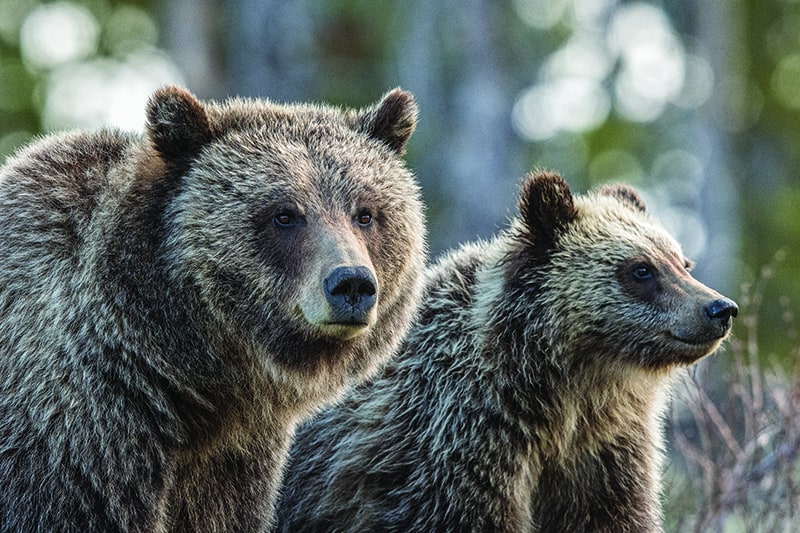
A grizzly sow and her cub. Photo by Jeff Vanuga

“I hate myself for killing her, I really do,” says Noah Kolis, who shot a grizzly sow last May after it had charged to within 15 feet of him while on a hike near New Fork Lakes. Photo by Ryan Dorgan
NOAH KOLIS REACHED for his Smith & Wesson Model 460V revolver before setting off for a hike from his childhood home with three Midwestern college buddies visiting for his friend’s bachelor party. The 24-year-old Jackson Hole resident, who grew up in Cora, about a 75-mile drive from Jackson, and his friends were hiking in wild country that he knew contained grizzly bears—he’d even seen tracks that same morning. Normally Kolis carries bear spray, but this time, he eschewed that nonlethal deterrent. “I honestly don’t know what made me grab a gun as opposed to bear spray,” he says. “I remember thinking multiple times, ‘Just grab a can of bear spray.’ I didn’t, and just grabbed the revolver instead.” The group’s hike up to some chimney rocks north of New Fork Lakes was going swimmingly, until the home stretch when they headed off-trail up a steep pitch.
It was Lily, Kolis’ dog, who alerted the group that something was up. The retriever mix started acting funny, as if she was checking out a large animal like a moose. And she was intrigued by an animal, but it wasn’t a moose. Kolis saw Lily was unnervingly close to a sow grizzly bear with two young cubs and began screaming to recall his dog. Lily didn’t respond, though, and the protective mother did what grizzly bears do when they perceive their offspring are threatened: She charged. The bear flew downhill after Lily and toward the four strung-out men. “I was exceedingly surprised how fast that bear could move,” Kolis says. The groomsman nearest Kolis sprinted away from the charging bruin, a mistake that could have further inflamed the big bear’s inkling to attack. Kolis knew better and stood his ground. With just a dozen feet of separation, he was face to face with a member of the Ursus arctos horribilis clan, and she wasn’t happy.
Kolis’ last memory before making the decision to fire was glancing down at the at the sow’s finger-length claws curling off her paws. He thought, “Those will kill you.” Kolis’ bullet struck the stationary bear in the cheek, and she fell, though he had to fire three more times to end her misery. Immediately, Kolis was cursing up a storm and livid—not at the bear, but himself. “With the pull of my finger, I just killed three bears,” he says. “When I called my parents afterwards, and when the game wardens were walking through the scene, I was crying. Not due to shock, or the adrenaline, but due to the fact that I felt like a monster for killing her and, in effect, her cubs, too.”
HISTORICALLY, TENS OF thousands of grizzlies fanned out across a native range that covered most of the American West, from the western Great Plains to California. Clashes between the species, whose scientific name is Ursus arctos horribilis, and Lewis and Clark’s 1804-06 expedition foretold a deadly century ahead for the bears. By the early twentieth century, trappers and settlers in the Lower 48 states had successfully exterminated grizzlies from all but six isolated and mountainous areas. The largest of these were in and around Glacier and Yellowstone National Parks. By 1975, fewer than a couple hundred grizzlies remained in the Greater Yellowstone Ecosystem (GYE), mostly confined to Yellowstone itself. That year the species was afforded protections by the Endangered Species Act, which was new at the time.
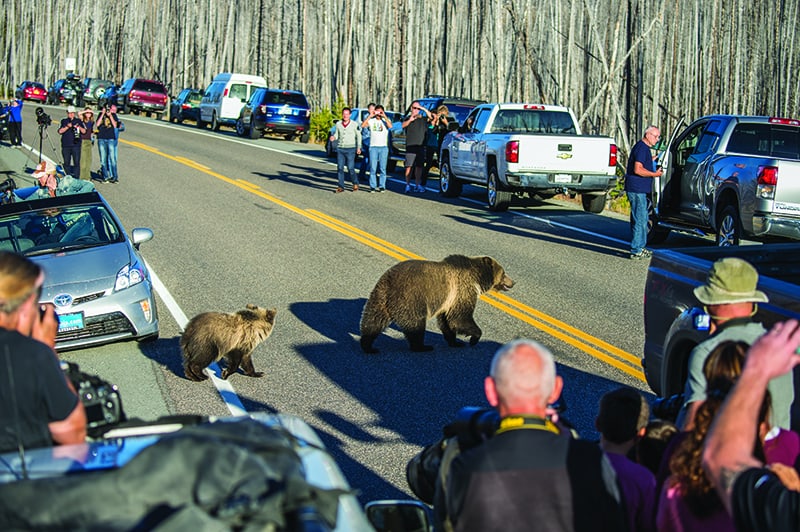
A grizzly bear and her cub pass through a group of tourists at a bear jam in Yellowstone National Park. Yellowstone and Grand Teton require people to stay at least 100 yards away from bears at all times. Photo by Jeff Vanuga
The Endangered Species Act worked. The grizzly population slowly swelled to more than 700 animals, where it’s remained for about the last decade. Although wildlife managers do not attempt to tabulate grizzly numbers at the fringes of their range, and the grizzly range is expanding. Today, grizzly bears are found from the southern Wind River Range north all the way to the mountains rimming Bozeman, Montana.
While the species’ recovery in the area is a conservation success story, its presence in new places can also be problematic. With more grizzlies in more places, there has been an increasing number of conflicts between them and humans (and our domestic animals and infrastructure). “It’s a function of more bears on the landscape, and especially more bears in human-dominated areas,” says Wyoming Game and Fish Department large carnivore supervisor Dan Thompson. “Really in the last four to five years, we’ve really seen things ratchet up to this critical mass level as far as what we’re seeing with conflicts throughout Wyoming and the GYE.”
Grizzly bears aren’t unusual in wildlands around Cody, but having them wander into Gallagher’s Corn Maze and Pumpkin Patch, in Clark, north of Cody, is. Last fall, grizzlies visited the maze and pumpkin patch on three separate occasions.
Last summer a grizzly family was seen further east than any other time in decades, near Byron in Wyoming’s Bighorn Basin. Another boar bear in the area drowned in a fast-flowing, cement-sided canal. Grizzly bears aren’t unusual in wildlands around Cody, but having them wander into Gallagher’s Corn Maze and Pumpkin Patch, in Clark, north of Cody, is. Last fall, grizzlies visited the maze and pumpkin patch on three separate occasions. “It’s ecologically and philosophically fascinating to see bears expanding into these areas where they haven’t been for hundreds of years,” Thompson says. “But there’s also a much higher potential for very negative things to happen, including human injuries and deaths, that could put a quick damper on all the work that we’ve done.” Last September, a grizzly fatally mauled Jackson-based hunting outfitter Mark Uptain in the Teton Wilderness.
The bears that killed Uptain, as well as the Byron and pumpkin patch bears were caught and killed by authorities. In total, 69 of the hump-backed bruins are known to have died or been killed last year. This gives 2018 the distinction of being the deadliest year for grizzly bears in recent history, and perhaps since early Americans settled the West and made a concerted effort to eradicate the species. (Still, the states of Wyoming and Idaho deemed the grizzly population high enough that both planned to hold the first hunting season for the species in the Lower 48 states in 44 years. Days before the season opened, though, U.S. District Court Judge Dana Christensen ruled from Montana that federal wildlife officials had violated the Endangered Species Act. The states’ jurisdiction, and ability to hunt grizzles, was gone. Wildlife activists celebrated, but the ranching and outfitting communities—and the states—loathed what they perceived as judicial overreach. This grizzly nonhunt is a whole separate story. If you want to read more, search the online archives of our sister publication the Jackson Hole News&Guide at jhnewsandguide.com.)
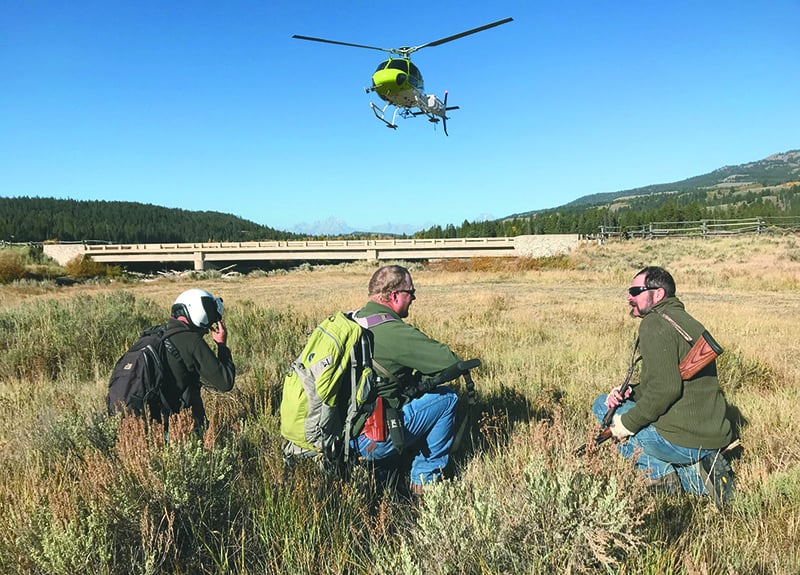
Wyoming Game and Fish Department large carnivore biologists Mike Boyce, Brian Baker, and Dan Thompson keep their heads low as a helicopter descends at a staging area near the Buffalo Fork River. Minutes later, the trio of biologists was inserted onto the slopes of the Teton Wilderness’ Terrace Mountain, tasked with checking foothold snares that were set to trap the pair of grizzly bears suspected of killing hunting outfitter Mark Uptain. Photo by Mike Koshmrl
LONGTIME GRIZZLY BEAR activist Louisa Willcox, of Livingston, Montana, says the states unfairly attribute grizzly bears gaining new ground on the landscape as the only explanation for why lethal conflicts are up. Grizzlies are generalist eaters—one study found that bears here consume 266 species of animals and plants—but the Greater Yellowstone Ecosystem’s population is particularly carnivorous, federal scientists say. As choice backcountry food sources like whitebark pine seeds have declined, they’re shifting to a more meat-based diet. Some forms of meat are relatively innocuous, like winter-killed elk and, in the spring, elk calves and deer fawns. But two other sources of meat grizzlies are taking a liking to are not: livestock and gut piles and carcasses left by human hunters. “With open-range cattle and hunter conflicts, there are not clear solutions,” veteran bear conflict specialist Steve Primm says.
An annual summertime clash between grizzlies and cattle occurs all around the ecosystem, but nowhere is it more chronic than in Upper Green River country, specifically on Bridger-Teton National Forest grazing leases that start about 30 miles east of Jackson. Albert Sommers, a fourth-generation cattle rancher and Wyoming state representative who presides over the Upper Green River Cattle Association, recalled one midsummer morning last year when his riders were tasked with driving cattle from one fenced allotment into the next. “There were 1,700 cattle in a 40-acre area, and there were three grizzly bears in there,” he says. The bears’ presence made the cattle jumpy and difficult to move, but that’s not his foremost
concern. Every year, grizzlies (and wolves) kill dozens of cattle. “We’re sick of it,” Sommers says. “It’s hard to watch your animals get eaten. Our confirmed loss numbers were pretty high last year, in the eighty-something range between bears and wolves.” Last year, in response to these depredations, which cattleman are reimbursed for by the state of Wyoming, carnivore biologists caught nineteen grizzlies in traps in the Upper Green. Most of these bears were relocated to a wilder environment and released, but seven repeat offenders were killed.
Hunters encountering and, at times, defensively shooting grizzlies, is also becoming more commonplace. In an average year, around ten grizzlies are defensively or mistakenly shot and killed in the Greater Yellowstone Ecosystem, but this number is increasing and there are places where conflict has become routine. The Teton Wilderness and Absaroka Front (west of Cody) are perhaps the two most conflict-ridden nooks of the region. During the big-game hunting seasons, sightings of grizzlies should be expected in both areas, and the bears here have learned to rely on hunters’ harvests as an important source of food. “These are places that have really high densities of bears,” Primm says, “and they’ve had a few bear generations learning that [gut piles and carcasses] are really good ways to get a meal.” Frequently, grizzlies find and feed on hunter-killed elk and deer that have been cached overnight. (Hunters would cache their kill because they don’t have enough daylight to transport it out.) When the hunters return to their cache the following day, they encounter a bear. Less often the encounters are reversed, and grizzlies aggressively approach a kill regardless of who’s already on the scene.
Such was the case with Uptain, a longtime Jackson Hole resident, hunting guide, and father of five who was helping his Floridian client, Corey Chubon, clean up and pack out a bull elk atop the Teton Wilderness’ Terrace Mountain. As the men worked, an adult female with a cub came pounding uphill at a full charge. Investigators determined the meat-seeking sow would have come into view with only about 10 yards of separation, which would have given Uptain less than one second to respond. There wasn’t enough time to unholster and engage the canister of bear spray slung from his hip, let alone grab his 10-millimeter Glock handgun, which was stashed a few yards away. Eventually, Uptain was able to repel the bruin with a blast of bear spray, but not before he sustained lethal injuries. His body was found the next day 50 yards from the carcass.
“This one I think hit home a lot closer to a lot of people,” Thompson says of the guide’s death. “It really brings home the reality of grizzly bears on the landscape. Mark knew what he was doing.” Primm worries the incident will erode tolerance, and make hunters more fearful. “That one has [had] a really big effect on how people perceive our future with grizzly bears,” Primm says. “If it seems like they’re really, really dangerous and there’s nothing we can do about it, we’re going to be pretty discouraged and have a really limited sense of possibility.”
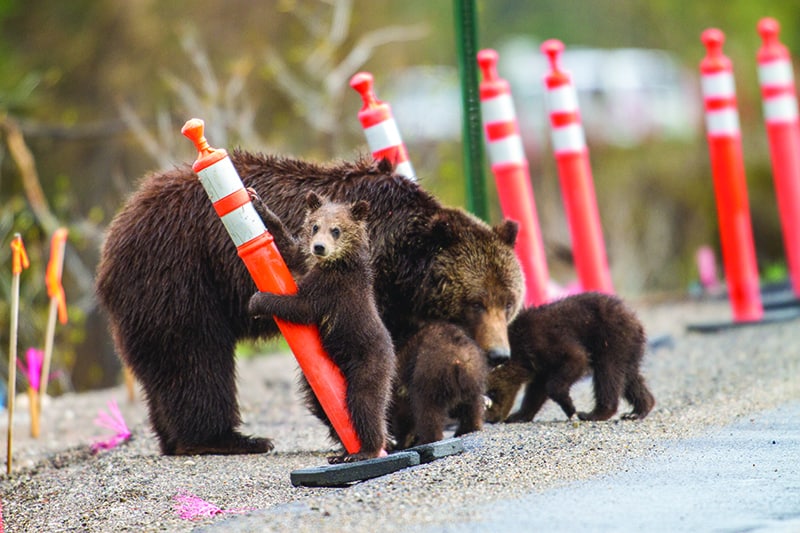
Grizzly 399’s third set of triplets plays with traffic cones near Pilgrim Creek in Grand Teton National Park shortly after they emerged from their den in 2013. Photo by Henry H. Holdsworth
BUT THERE ARE blueprints in the Greater Yellowstone Ecosystem for making major headway on conflicts with the species. In the early days of the twentieth century, rangers in Yellowstone National Park recorded nearly fifty bear-caused human injuries in the park each year, and now they’re exceedingly rare. Most years grizzlies don’t injure any of the park’s four million-plus visitors. What changed? The park modified the behavior of the animals and of people: After decades of bears relying on open-air garbage dumps for food and of people thinking grizzlies walking up to their cars was cute, Yellowstone kept bears away from trash and fined visitors who fed them or left food in their car (that the bears could break into and get).
More recently, some of Yellowstone’ gateway communities have turned the tide on what were once chronic conflict issues. In the late 1990s, Cooke City, Montana, had a reputation as a grizzly “black hole.” Bears got into the municipal dump and/or residential garbage and came to think of human trash as a food source. They lost their fear of humans. Because of this habituation, grizzlies were often eventually euthanized. But then Montana state biologists visited the community with a couple decades of conflict and dead bear data. “Putting that map up and talking about what was going on brought people who were ideologically on opposite sides of the issue together,” Willcox remembers. “People had their arms crossed and their eyes were rolling. But that conversation pretty quickly went to a community commitment to do something, in that case about garbage.”
Willcox wishes that wildlife managers today would duplicate this effort by dissecting the data and having a solutions-based discussion about grizzly bear-hunter conflict. “Hunters are coming from all over,” she says. “What kind of information are hunters getting before they get here? How can we make sure that the guy who’s in his hotel room in Dubois or wherever is actually seeing some material about the mindset of going into grizzly bear country?” Hunting—essentially creeping silently around the woods—and naturally protective, aggressive grizzly bears are an inherently problematic mix, and some hunter-grizzly interactions will likely always result in bears getting shot. “They’re surprise encounters,” Primm told the Jackson Hole News&Guide in 2015. “The person is walking along with a rifle in their hands and here comes this Pleistocene carnivore barreling at them at 35 miles an hour. They’re probably going to take a shot to protect themselves, whether they consciously wanted to or not.”
The Greater Yellowstone Coalition (GYC), a nonprofit founded in 1983 to protect the lands, waters, and wildlife of the Greater Yellowstone Ecosystem, has installed 1,194 bear-proof food storage boxes and also bear-proof dumpsters and informational kiosks at every public campground in the ecosystem. Avid big game hunter and GYC employee Chris Colligan spearheaded this effort, which was logistically challenging and a big investment. (The GYC spent $600,000 on the project and partnering agencies and organizations contributed another $1.3 million.) “The campground project for us was a really good template, because we’re also working on trying to increase hunter safety and reduce conflict with livestock producers,” Colligan says. “We’ve got pilot projects started around those things, but the question is how do you take them
to scale?”
Knowing how to properly use bear spray is just one part of safely spending time in grizzly country.
Hunter education is key. Knowing how to properly use bear spray is just one part of safely spending time in grizzly country (see the sidebar on page 77). Knowing to watch for ravens and magpies, telltale signs of a carcass nearby, can help avert close encounters. Bear-smart hunters also steer clear of thick timber in places where grizzlies are likely to be bedded. Colligan has changed his hunting habits significantly over his 15 years in the valley because of grizzlies. Today he does not hunt solo or hunt after work. (He does the latter to limit the chance that he shoots an animal late in the day and has to cache meat in the field overnight.) Last season, he began carrying two canisters of bear spray. Just like with backcountry skiing, Colligan says, people need to be aware of the risks that come with hunting in grizzly country, and make intentional decisions to minimize those risks. “It’s part of what makes the Greater Yellowstone Ecosystem really special,” Colligan says, “to be a part of an ecosystem where you’re not the top of the food chain, and you have to change your behavior.”
There are also blueprints for reducing conflict with livestock, though no obvious approaches that promise to slow the bovine and ursine bloodshed in the Upper Green. Stockmen in Montana’s Blackfoot and Centennial Valleys have made great strides toward grizzly coexistence on large privately held ranches by using electric fences around pastures where cows are calving and getting rid of livestock bone yards. It’s hard to duplicate those efforts on the Bridger-Teton allotments where Sommers runs his cattle because of the enormity of that grazing complex, which encompasses hundreds of square miles and spans the entire national forest from north to south. Sommers partnered with the Greater Yellowstone Coalition and People and Carnivores, Primm’s former employer, on an experimental herding technique designed to keep cattle bunched up and away from grizzlies. It didn’t work, though, and the project ended. For better or worse, Sommers says he’s become inured to the conflict. “We’re going to lose some cattle, and there’s going to be some bears lost,” he says. “I guess in the end we’re the experiment, right? I hope we can figure out a way to get a handle on it, but we just haven’t done so yet.”
Coexistence is also instilled through culture. U.S. Fish and Wildlife Service grizzly bear recovery coordinator Hilary Cooley’s prior job was working with polar bears in Alaska, where there are also grizzly bears (and where grizzlies were never almost wiped out like they were in the Yellowstone region). “Of course we’re never going to stop all grizzly bear mortalities, but I definitely think that as people get used to living with bears it will get easier,” Cooley says. “There’s lots of work being done to secure attractants and teach people. A lot of that is ongoing, but as bears move into new places people have to catch up. It just takes time.” Willcox’s take is that the sticky remnants of the settler mentality—when large carnivores were the sworn enemy, and largely wiped out—are still handicapping efforts to coexist. “We don’t tell the stories of coexistence with grizzly bears, because we got rid of them except for these isolated, tiny postage stamps,” Willcox says. “Bears are asking us to transform ourselves, and they’re asking us for a little humility, because they don’t have anywhere else to go. This is about us transforming. The tools are fine, but this is going to take a broader cultural commitment.”
Bear spray best practices
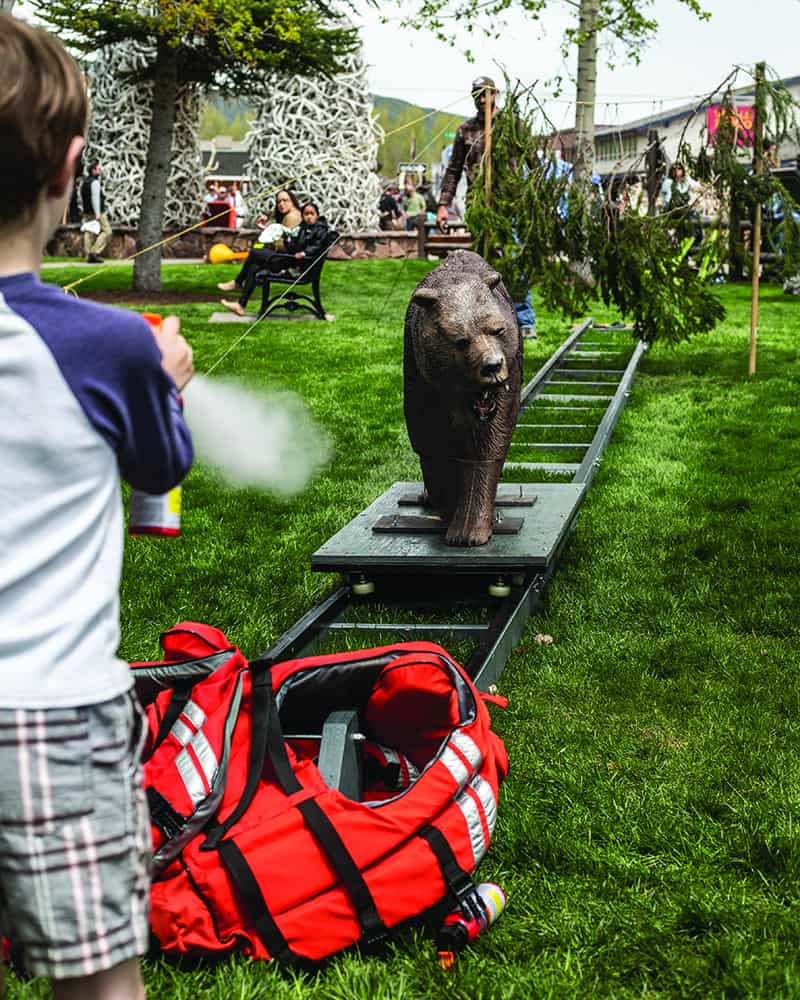
The Greater Yellowstone Coalition gave people a chance to test their reaction time deploying bear spray at last year’s ElkFest with a decoy charging bear. Photo by Ryan Dorgan
Not all informational pamphlets about the proper use of bear spray are created equal, says Chuck Bartlebaugh, a Missoula, Montana, resident who founded the Be Bear Aware campaign (bebearaware.org). “The agencies keep looking for a way to get hunters using more bear spray, and the way is simple: A clear, concise, and consistent message,” Bartlebaugh says. “We do not have that. We don’t even come close.”
Bartlebaugh says bear spray users should rehearse accessing and using their canisters to the point where it’s muscle memory, because the likelihood is that they will have two seconds or less to respond. A grizzly bear charging at 30 miles an hour that first comes into view from 20 yards away will close the gap in 1.4 seconds. “You deploy your bear spray by pulling it out of the holster, and as it’s coming out of the holster you’re pulling [the safety] with the front of the curled-up lip,” Bartlebaugh says. “Deploy the bear spray downward toward the charging bear. You just spray, don’t aim for the bear. Continue spraying until that bear says I’ve had enough. Do not use a short burst to see if it works.”




